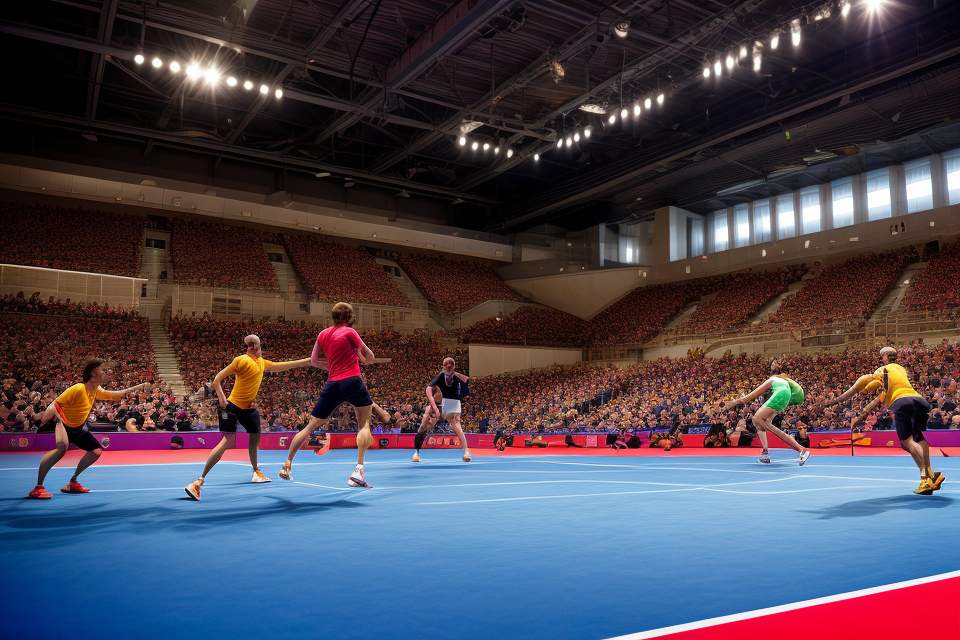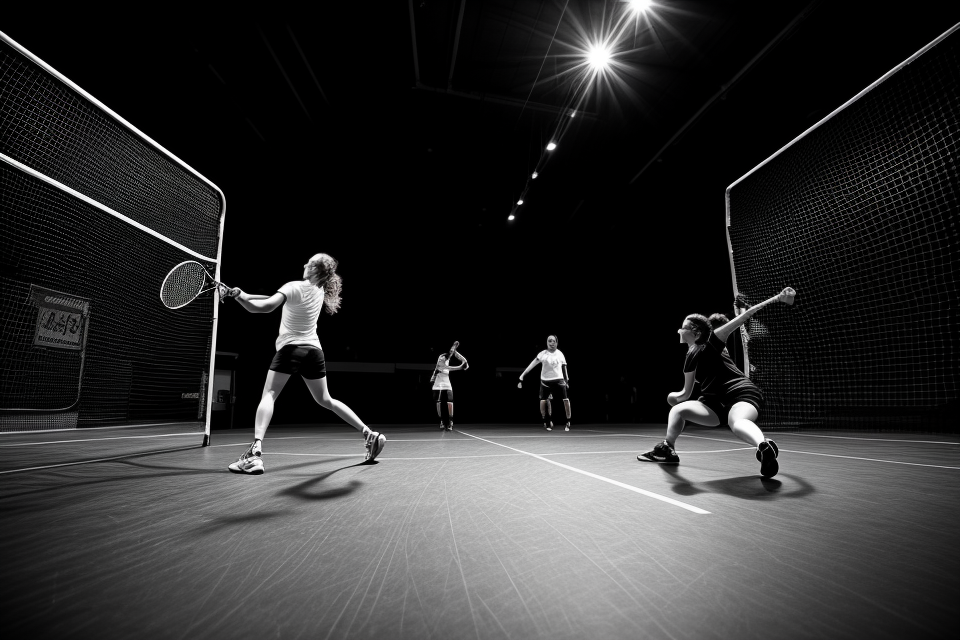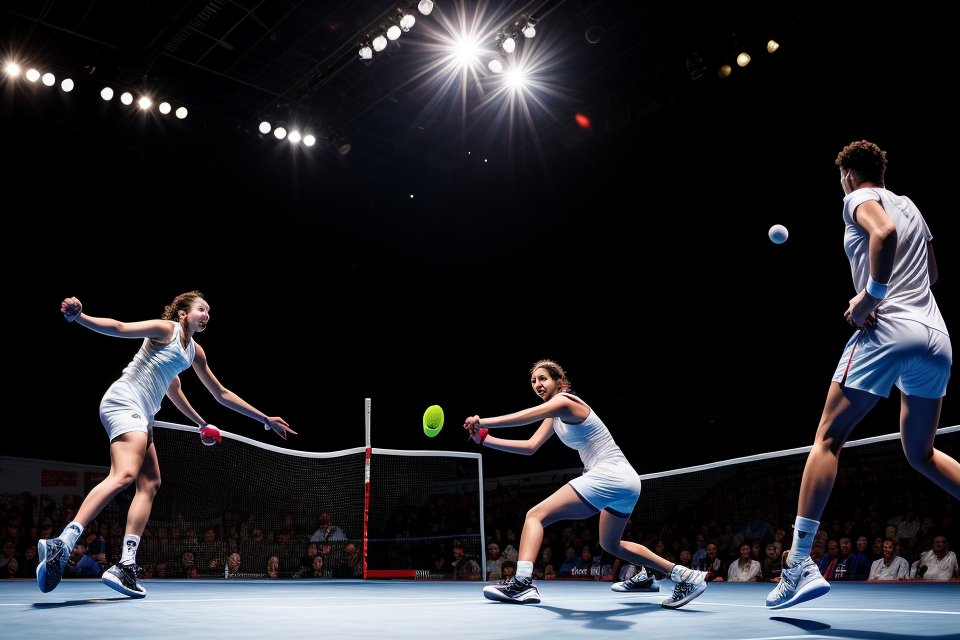Squash is often considered one of the most challenging sports due to its high-intensity and physical demands. With its fast-paced and dynamic nature, squash requires exceptional fitness, tactical prowess, and mental fortitude. Many athletes have described squash as a combination of tennis, basketball, and martial arts, making it a sport that tests the limits of both body and mind. But is squash truly one of the most difficult sports? In this article, we will explore the physical and mental demands of squash and examine why it is considered one of the toughest sports around. So, gear up and get ready to discover the true intensity of squash!
The difficulty of a sport is subjective and can vary depending on individual perspectives and experiences. While squash may require a high level of physical fitness, skill, and strategy, it is not necessarily the most difficult sport. Sports like rock climbing, boxing, and mixed martial arts, for example, have a reputation for being very challenging and demanding. Additionally, the difficulty of a sport can also depend on factors such as equipment, playing surface, and rules. Ultimately, whether or not squash is one of the most difficult sports is a matter of personal opinion.
Understanding the Basics of Squash
The Court and Equipment
Squash is a unique sport that requires a specific court and equipment to play. The court is typically made of glass and is surrounded by walls that help to keep the ball in play. The court dimensions are 16 feet wide and 32 feet long, with a ceiling height of at least 15 feet.
In terms of equipment, players are required to wear shoes with non-marking soles to prevent damage to the court. Additionally, players are required to wear eye protection to prevent injury from the ball. The ball used in squash is similar to a racquetball, but is slightly smaller and has a different bounce.
Players also use a racquet that is similar to a tennis racquet, but with a smaller head and a longer handle. The racquet is used to hit the ball against the wall of the court, with the goal of making it difficult for the opponent to return.
Overall, the court and equipment requirements for squash can be challenging for new players to master. However, with practice and patience, anyone can learn to play the sport and appreciate its unique demands.
The Rules and Scoring System
Squash is a unique sport that combines elements of athleticism, strategy, and endurance. In order to understand why it is considered one of the most difficult sports, it is important to familiarize oneself with the rules and scoring system.
The game of squash is played on a four-walled court, with players using a small, hard, and lightweight rubber ball and a racquet to hit the ball against the wall. The objective of the game is to hit the ball in such a way that it forces the opponent to make a mistake, resulting in a point for the serving player.
Here are some key aspects of the rules and scoring system in squash:
Rally Point System
The rally point system is used to determine the winner of a point. The ball must be returned by the opponent to the side of the court where the serving player is standing. If the opponent makes an error, such as hitting the ball out of bounds or into the net, the serving player wins the point.
Serving
In squash, the serve can be hit to any part of the wall above the service line. The ball must be hit with the racquet in a downward motion and must pass beyond the non-volley zone before it hits the wall. If the serve is successful, the player serves again.
Match Format
A match is typically played best of three or five games, with each game being played to a score of 11 points. The player who reaches 11 points first must win by a margin of two points. For example, if the score is 11-10, the player who is ahead by one point must win by two points to win the game.
Let System
In the event that the ball hits the side wall or the ceiling before it hits the front wall, a let is called. This means that the point is replayed with the players switching sides of the court.
Overall, the rules and scoring system of squash can be complex and challenging to master. The combination of physical exertion, strategic thinking, and mental fortitude required to excel at the sport make it a true test of athleticism and mental toughness.
The Physical Demands of Squash
Fitness Requirements
Squash is often regarded as one of the most physically demanding sports due to the high level of fitness required to excel at the game. Players need to be in top physical condition to endure the fast-paced and physically demanding nature of the sport. In this section, we will delve into the specific fitness requirements that squash players need to possess in order to be successful.
Aerobic Endurance
Squash is a sport that requires players to be in excellent cardiovascular shape. Matches can last up to 90 minutes or more, and players need to have the stamina to maintain a high level of intensity throughout the match. Therefore, squash players require a high level of aerobic endurance to be able to sustain their energy levels and perform at their best for extended periods of time.
Muscular Strength and Endurance
Squash players need to have well-developed muscles to be able to execute the various shots and movements required in the game. This includes the muscles in the legs, core, and upper body. Muscular strength and endurance are crucial in squash as they enable players to move quickly and efficiently around the court, make powerful shots, and maintain their balance during rallies.
Agility and Flexibility
Agility and flexibility are also important fitness requirements for squash players. The fast-paced nature of the game requires players to be able to change direction quickly and make sudden movements. Additionally, the tight spaces on the squash court demand that players have good footwork and be able to move around easily. Squash players need to have a high level of flexibility to be able to make sharp turns and reach for balls in tight spaces.
Speed and Reaction Time
Speed and reaction time are crucial in squash as the game is played at a very fast pace. Players need to be able to move quickly around the court and react to their opponent’s shots in a split second. The ability to move quickly and react to different situations is a critical fitness requirement for squash players.
In conclusion, squash is a sport that demands a high level of physical fitness from its players. To excel in the game, players need to possess a combination of aerobic endurance, muscular strength and endurance, agility, flexibility, and speed. These fitness requirements are essential for squash players to perform at their best and compete at the highest level.
Skill Set Necessities
To be considered among the most difficult sports, a physical activity must require a unique combination of strength, agility, and endurance. Squash, a racquet sport played in a four-walled court, is often touted as one of the most demanding sports in terms of physical fitness. To explore this claim, let us examine the skill set necessities that make squash a challenging sport.
- Endurance and Stamina: Squash matches can last up to 90 minutes, and players are required to move continuously around the court, making it one of the most physically demanding sports. The continuous running, jumping, and changing direction during the game can make squash an incredibly demanding sport, testing players’ endurance and stamina levels.
- Quick Reflexes and Coordination: Squash demands quick reflexes and exceptional hand-eye coordination from players. The speed of the ball, the precision required for shots, and the constant movement on the court all contribute to the development of reflexes and coordination skills. Players need to be agile and have excellent footwork to be successful in squash.
- Strength and Power: Although squash is not as physically demanding as sports like football or rugby, it still requires players to have a certain level of strength and power. The ability to hit the ball with power and accuracy is crucial in squash, and players need to develop their upper body strength to achieve this. Squash also requires players to have a certain level of core strength to maintain balance and stability during play.
- Mental Focus and Agility: Squash is not just a physical sport; it also requires a high level of mental focus and agility. Players need to be able to think quickly on their feet, adapt to changing situations, and strategize to outsmart their opponents. Mental toughness and the ability to stay calm under pressure are also essential traits for a successful squash player.
In conclusion, the physical demands of squash make it a challenging sport that requires a unique combination of strength, agility, and endurance. The continuous movement, quick reflexes, and mental focus necessary for success in squash contribute to its status as one of the most difficult sports.
The Mental Aspects of Squash
Strategic Thinking
Squash is a sport that demands a high level of strategic thinking from its players. Unlike other sports, squash is played in a confined space, which means that players must be constantly aware of their surroundings and think ahead about their next move. This requires a great deal of mental focus and concentration, as well as the ability to analyze the game and make quick decisions.
One of the key aspects of strategic thinking in squash is the ability to read your opponent’s movements and anticipate their next move. This involves paying close attention to their body language, footwork, and shot selection, and using this information to make informed decisions about your own play. It also requires a deep understanding of the game’s rules and tactics, as well as the ability to adapt to changing circumstances on the court.
Another important aspect of strategic thinking in squash is the ability to manage your energy and momentum throughout the game. This involves knowing when to conserve energy and when to push forward, as well as being able to make quick changes of direction and speed. It also requires a high level of mental toughness and resilience, as well as the ability to stay focused and motivated even when things are not going your way.
Overall, the mental aspects of squash are a crucial part of the game, and players who are able to think strategically and make quick decisions are often the most successful. Whether you are a beginner or an experienced player, developing your strategic thinking skills can help you to improve your game and achieve your goals on the court.
Adaptability and Resilience
The Importance of Adaptability in Squash
Adaptability is a crucial aspect of squash, as it requires players to be able to adjust their strategies and tactics on the fly. The dynamic nature of the game means that players must be able to react to changes in their opponent’s play, as well as changes in the court conditions. For example, if a player is used to playing in a fast-paced game, they may need to adapt their strategy if they find themselves playing on a slower court.
The Importance of Resilience in Squash
Resilience is another key mental aspect of squash, as it requires players to be able to bounce back from adversity. The game can be unpredictable, and players will inevitably face setbacks, such as losing a point or a game. Players who are mentally tough and resilient are better able to handle these setbacks and maintain their focus and composure. They are also more likely to be able to turn the game around and make a comeback.
The Link Between Adaptability and Resilience
Adaptability and resilience are closely linked in squash, as players must be able to adapt to changing circumstances while also maintaining their focus and composure. For example, if a player is facing a tough opponent, they may need to adapt their strategy and tactics while also remaining resilient in the face of adversity. This requires a high level of mental toughness and the ability to stay focused and composed under pressure.
Conclusion
In conclusion, adaptability and resilience are two key mental aspects of squash that can have a significant impact on a player’s performance. Players who are able to adapt to changing circumstances and remain resilient in the face of adversity are better equipped to handle the unpredictable nature of the game and are more likely to achieve success.
The Injury Risks in Squash
Common Injuries
Squash is a physically demanding sport that requires quick movements, agility, and endurance. As a result, it is not uncommon for players to sustain injuries while playing. The following are some of the most common injuries that players may experience:
Back Injuries
Squash is a sport that requires a lot of running and jumping, which can put a lot of strain on the back. The constant change of direction and sudden stops can lead to back injuries such as herniated discs, strained muscles, and ligament sprains.
Wrist Injuries
Squash is played with a small rubber ball that is hit with a racquet. The repetitive motion of hitting the ball can cause wrist injuries such as tendonitis, carpal tunnel syndrome, and fractures.
Knee Injuries
The constant movement and change of direction in squash can put a lot of stress on the knees. Players may experience knee injuries such as patellar tendonitis, meniscus tears, and anterior cruciate ligament (ACL) tears.
Ankle Injuries
Squash involves a lot of lateral movement and sudden stops, which can put a lot of stress on the ankles. Players may experience ankle injuries such as sprains, strains, and fractures.
It is important for players to take the necessary precautions to prevent injuries, such as warming up properly, stretching, and using proper technique when hitting the ball. In addition, players should listen to their bodies and take breaks when necessary to avoid overexertion and injury.
Prevention and Safety Measures
One of the reasons why squash is considered to be a challenging sport is due to the potential for injury. Squash is a fast-paced and physically demanding sport that requires a high level of physical fitness, strength, and endurance. It also involves rapid changes in direction, sudden stops, and jumps, which can put a lot of stress on the body and increase the risk of injury.
To reduce the risk of injury in squash, it is important to take preventative measures and follow safety guidelines. Here are some of the key prevention and safety measures that players can take to stay safe on the squash court:
- Warm-up and cool-down: It is important to warm up before playing squash to prepare the muscles for physical activity. This can include light stretching, jogging, or dynamic exercises such as lunges or leg swings. After playing, it is important to cool down and stretch to reduce the risk of injury and prevent muscle soreness.
- Proper footwear: Wearing appropriate footwear is crucial in squash. Players should choose shoes that provide good support, cushioning, and traction on the court surface. A good grip on the court can help prevent slips, trips, and falls, which can result in injuries.
- Proper technique: Using proper technique is essential in squash to reduce the risk of injury. This includes the correct grip on the racquet, proper stance, and movement patterns. Players should also avoid overexertion and use proper weight transfer and balance to prevent strain on the body.
- Hydration: Staying hydrated is important in any physical activity, including squash. Players should drink plenty of water before, during, and after playing to prevent dehydration, which can affect performance and increase the risk of injury.
- Rest and recovery: Rest and recovery are crucial in preventing injury in squash. Players should allow enough time for rest and recovery between matches and training sessions. This can include stretching, foam rolling, or massage to help prevent muscle soreness and injury.
By following these prevention and safety measures, players can reduce the risk of injury and stay safe on the squash court. It is important to remember that squash is a physically demanding sport, and taking the necessary precautions can help players perform at their best and avoid injury.
Comparing Squash to Other Sports
Physical Comparison
Squash is often considered one of the most physically demanding sports, but how does it compare to other sports in terms of physical exertion? To answer this question, it is important to examine the physical requirements of squash and compare them to those of other sports.
- Endurance: Squash is a sport that requires a high level of endurance due to the continuous running and movement on the court. The average player can expect to cover up to 3 miles during a match, making it comparable to sports such as soccer and basketball.
- Strength: Squash also requires a certain level of strength, particularly in the legs and core. The repeated hitting of the ball with a racket can put a lot of strain on these areas, making it a physically demanding sport. Comparable sports include tennis and badminton.
- Agility: Squash also requires a high level of agility and quick reflexes, as players need to be able to move around the court quickly and make split-second decisions. This aspect of the sport is comparable to sports such as soccer and basketball.
- Coordination: Squash also requires a certain level of coordination, as players need to be able to hit the ball with precision and control their movements on the court. This aspect of the sport is comparable to sports such as golf and tennis.
Overall, it is clear that squash is a sport that requires a high level of physical exertion in several areas. While it may not be the most physically demanding sport in every aspect, it is certainly up there with some of the toughest sports around.
Mental Comparison
While it is often argued that squash is one of the most mentally demanding sports, it is essential to compare it to other sports in order to fully understand the nature of its mental challenges. Here are some factors that highlight the mental demands of squash:
- Adaptability: Squash requires players to be adaptable to different game situations. They must be able to adjust their strategy and tactics based on their opponent’s strengths and weaknesses, as well as the dynamic nature of the court. This mental agility is a key aspect of squash and is often compared to the demands of chess.
- Concentration: Squash is a game that demands intense concentration. Players must focus on the ball, their opponent’s movements, and their own technique, all while maintaining a high level of physical exertion. This level of concentration is challenging and can be mentally exhausting, particularly during long rallies.
- Decision-making: In squash, players must make split-second decisions based on the movements of their opponent and the position of the ball. These decisions can have a significant impact on the outcome of the game, making squash a sport that requires both physical and mental strength.
- Mental toughness: Squash is a sport that requires mental toughness. Players must be able to handle pressure, maintain focus, and stay positive, even in the face of adversity. This mental toughness is a crucial aspect of squash and is often compared to the demands of sports such as golf and tennis.
Overall, the mental demands of squash are significant and comparable to other sports. While it may not be the most mentally demanding sport, it certainly requires a high level of mental fortitude and adaptability.
FAQs
1. What makes squash a challenging sport?
Squash is widely regarded as one of the most physically demanding sports. The combination of its unique playing characteristics—the fast-paced nature, the tight confines of the court, and the dynamic movement required—create a high level of physical exertion. Additionally, the strategic elements of the game require mental agility and sharp reflexes, which further contributes to the sport’s overall difficulty.
2. Is squash more challenging than other racket sports like tennis or badminton?
Each racket sport has its own unique set of challenges. Squash shares similarities with both tennis and badminton, but it stands out for its fast pace and the confined space of the court. The small size of the squash court, combined with the speed of the ball, makes it challenging to keep up with the rapid changes in play. Moreover, the physical demands of squash—such as the continuous jumping, lunging, and sprinting—are more pronounced compared to tennis or badminton.
3. What skills are required to excel in squash?
To excel in squash, a player needs to possess a combination of physical and mental attributes. Physical attributes include good hand-eye coordination, footwork agility, and endurance. Mental attributes include the ability to strategize, adapt to changing situations, and maintain focus under pressure. Moreover, squash requires a high level of technical proficiency, including precise strokes and accurate placement.
4. How do you train for squash?
Training for squash typically involves a combination of cardiovascular exercises, strength training, and technical practice. Cardiovascular exercises, such as running and cycling, help improve endurance and stamina. Strength training, focusing on the legs, core, and upper body, helps build the necessary power for executing shots. Technical practice involves mastering the strokes, footwork, and strategy specific to squash. Additionally, drilling and playing practice matches are crucial for developing match-related skills.
5. What is the learning curve like for squash?
The learning curve for squash can be steep, especially for beginners. Basic skills such as hitting the ball, moving around the court, and understanding the rules can take time to master. As players progress, they must develop their technique, strategy, and mental toughness. The difficulty of the sport means that even experienced players can continue to face challenges and work to improve their game.










